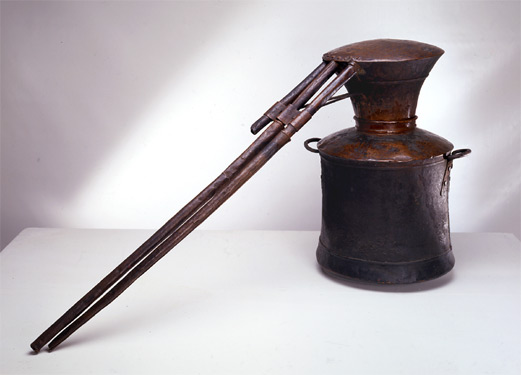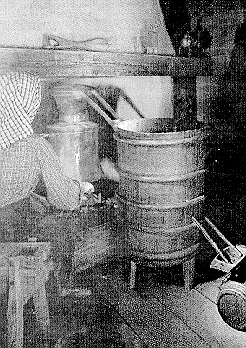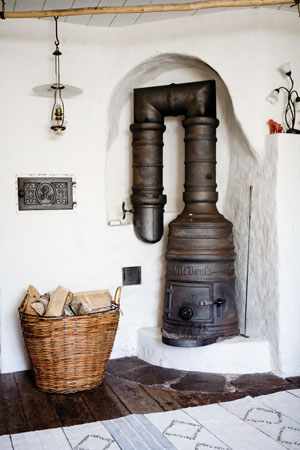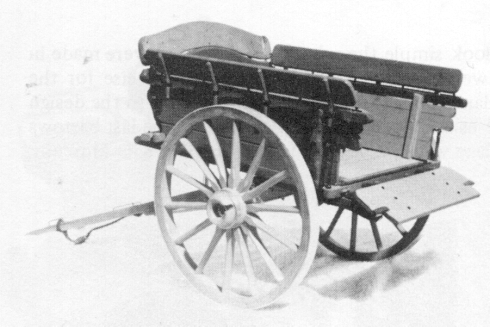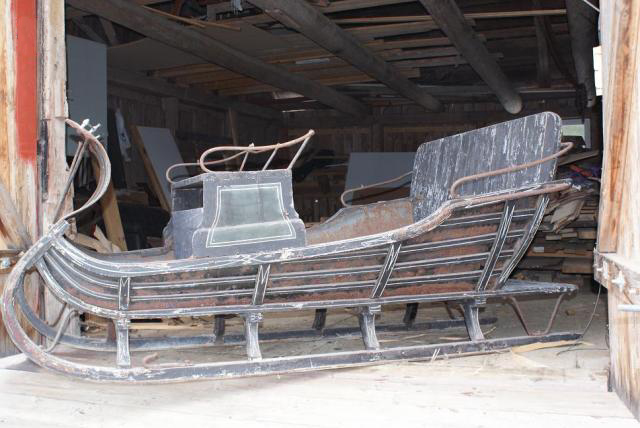INTERVIEW WITH THE WIDOW - 1
It is October 21, 1795 here in Hällefors parish and we are privileged to have with us Christina Pehrsdotter. Christina lost her husband, the late Sven Larsson, four weeks ago and we are on the estate today with some of her family who have assembled a team to perform the estate inventory and evaluation. Christina has agreed to let us interview her during the process in an unusual way. As I question her, I’ve asked her to pretend that she is answering someone who will be reading the interview in a different language and two centuries or more hence. The reader will know little of the dialect of this time and place, little of the objects and equipment that are in the estate, and little of the customs and practices that prevail.
Me: Why are we here today?
Christina Pehrsdotter: We are here to perform the bouppteckning for my late husband Sven Larsson.
Me: Now remember who we are addressing – what is the bouppteckning?
CP: Everyone knows that – it is the inventory and evaluation of all items in the estate and the determination of the distribution of everything to the heirs. This is required by the court after a death.
Me: Good – now who are all these people?
CP: Petter and Sven are my husband’s sons, Nils Nilsson Zander and Göran Andersson are his sons-in-law, and the other Nils Nilsson has been named guardian to the minor children.
Me: I understand Petter and Sven are both millers just as your husband was. Are the sons-in-law also millers?
CP: No, Nils is Maria’s husband - a tailor who lives in Kullberget, Södra Torp rote. Göran is Anna’s husband - a tenant farmer in Damshögden. Both of those places are here in Hällefors parish.
Me: There seem to be two other men here. Who are they?
CP: Swen Siggesson and Mats Persson are the “good men” who will conduct the inventory and assign the valuations. They have done estate inventories many times before.
Me: Besides Petter and Sven, I believe you have had several other children. How many, who are they, and how are they represented.
CP: My husband was married earlier to Brita Hindersdotter. They had eight children but only Maria, Lars and Sven survived. Maria is represented by her husband Nils Nilsson Zander. Lars is a bit slow in the head and is represented by his brother and guardian Sven.
Sven the elder and I had ten children, of which six survive. Petter is here today and Anna is represented by her husband Göran Andersson. Brita, Christina, Nils and Catharina are minors and they are represented by their appointed guardian Nils Nilsson from Hällefors.
Me: So you had ten children – how long were you and Sven married?
CP: Let’s see, we married in 1768 and it is now 1795, so it was 27 years. Sven was 18 years older than me.
Me: So Sven was pretty old when the minor children were born.
CP: Yes, my goodness, he was almost 65 when Catharina was born! I’ve always said, as long as butter will melt in their mouths, men will continue to try for more children!
Me: Do you recall how you lost the four children who died?
CP: Of course! Stina died of whooping cough when she was about 17 months old. I don’t think anyone knows for sure what causes infants to die, but the first Nils had severe stomach pains and the second Nils and Johan both had diarrhea.
Me: And how did Sven die?
CP: I think it was pneumonia.
Me: We are looking at the list of estate items. The items are grouped by various attributes. The first groups we will look at are Silver, Pewter, Copper, Brass, Bronze, Porcelain, Glass, and Iron and Tin. I see that you have several rather expensive pieces of silver Christina – how did that happen?
CP: As you said, Sven was a miller. Usually, he was paid by keeping a portion of the grain submitted by the customer, which we used for the family and sold any excess. In a good growing year this amounted to more grain than we could use or sell, and Sven resorted to what I think you would call barter. The silversmith was a good customer and he often paid with pieces of silver. Several other items in the inventory were acquired that way as well.
Me: The copper still with all its parts is a very expensive item. Was Sven a heavy drinker?
CP: Sven was a steady drinker, but probably no more so than his many friends. He was a hard worker and the drink never got in the way of his work. I admit that I have also had an occasional nip – after all, I was usually the one who ran the still!
|
Brännvinspanna med hatt och
pipor |
|
Me: The cast iron stove is another expensive item, right?
CP: Yes, but it was worth every bit of it – we all had many happy winter evenings huddled around the stove, enjoying the heat and the light of the flickering fire, telling stories, reading from the bible, and feeling like a family! I will truly miss those nights!
Me: I’m sorry for your loss Christina. Would you like to take a break from the questioning?
CP: No, I’m all right.
Me: Judging by the large number of plates, bowls, goblets, kettles, pots, casseroles, candlesticks and bottles of various materials, I’d guess you must entertain a lot. Is that the case?
CP: Well, if you call the serving of meals entertaining, the answer is yes! We always had tables full of people for meals – even when it was just family. And I was never one to “save” nice things – we would use the things we had and be grateful for them.
Most of the time we set up one table with all of the food on it and everyone could serve themselves – as you know, we call this smörgåsbord style. At Christmastime we have a special feast called julbord. Lots and lots of food has gone through my kitchen!
|
|
|
Me: I see broken iron casseroles and broken stoneware plates on the list. Why have you been keeping these?
CP: The iron was saved for the blacksmith. He can make it into other things. The stoneware plates can probably be repaired, but we never found anyone to do it.
Me: It seems that Sven didn’t have many hand tools – I guess he wasn’t very handy?
CP: Sven could do many things, but besides his milling work and tending the animals, he really preferred spending time with the children and fishing! We always had a small garden, but the children and I did most of the work. He would help with planting and the harvest of potatoes and rutabaga because that was heavy work but other vegetables were up to me. He also milked the cows, but the cheese and butter were up to us. He had the tools necessary to conduct his business.
Me: Yes, I see many grain bins, scoops, grain sieves, measuring devices, shovels, and carts that were probably a part of his business. I also see a few drills, saws, chisels and axes, probably for maintenance of equipment and buildings.
Next in the list come Vehicles and Farm Equipment. I see quite a few carts and sleighs as well as riding saddles, but no horses – how is that?
CP: We haven’t had horses for some time. The saddles and other horse tack are very old. The carts and sleighs were pulled by the ox that Sven the younger took prior to the inventory.
|
Kärra (cart) |
|
Me: There is a separate section for Fishing Equipment – Sven had 22 fish nets and four boats. Looks like he was serious about fishing.
CP: It was more than a hobby with him. Whenever he could get away from milling activities, Sven made pretty good money fishing. He would usually take one or more of the older boys or a son-in-law with him. He had one flat-bottomed row boat north on the Svartälven (Black River), one down the river and one at the small pond by Saxhyttan. The fourth boat was kept here and hauled along on other excursions.
Me: Linenware is next. You have some very elegant dräll table linens with an interesting block pattern. Did you get these for a special occasion?
CP: Yes, they were purchased for the marriage of Maria, Sven’s eldest daughter. Sven always felt bad for Maria because she was without a mother for more than a year and a half between Brita’s death and our marriage. Not only was she motherless, but she had three younger brothers and the baby Jonas to help out with. Brita died while giving birth to Jonas and then Jonas died when he was only 19 weeks old. I guess after all that, Sven tended to spoil Maria.
Me: This section is a list of all of Sven’s clothing. There are several items of clothing made of ”wallmarns”. Could you tell me what this material is?
CP: Huh, I can write better than these guys, and spell better as well! The word is actually “vadmal”, a rough woolen cloth, sometimes called homespun. I made some of these things and Anna became pretty adept and made other items.
(Continued in part 2)
NOTE FROM THE AUTHOR
You can see the actual bouppteckning that this information was taken from here and you can see more than 700 Swedish object words with pictures and their English translations here.
